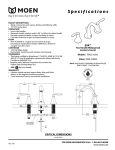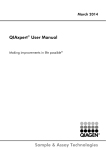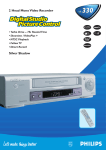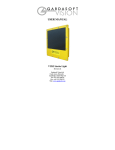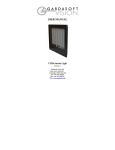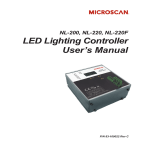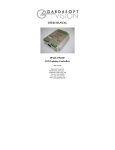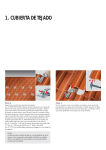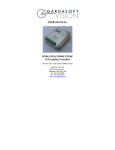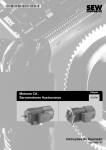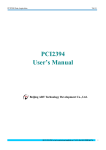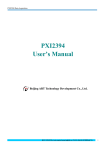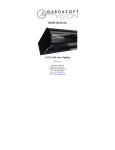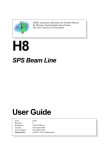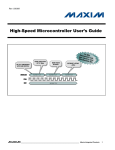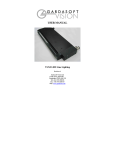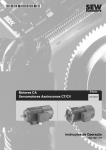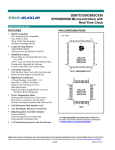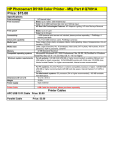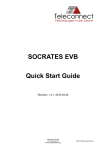Download USER MANUAL
Transcript
USER MANUAL RT200, RT220, RT260 RT200F, RT220F, RT260F RT420, RT420F, RT460, RT460F RT820F, RT860F LED Lighting Controller Revision 5 Gardasoft Vision Ltd Castle Acres, Elsworth Cambridge, CB23 4JQ. UK Tel: +44 1954 200343 Fax: +44 1954 204343 Web: www.gardasoft.com 2 1 Disclaimer Except as prohibited by law: All hardware, software and documentation is provided on an “as is” basis. It is essential that the user ensures that the operation of the product is suitable for their application. The user must ensure that incorrect functioning of this equipment cannot cause any dangerous situation or significant financial loss to occur. Gardasoft Vision Ltd and Gardasoft Products Ltd will not accept any liability for consequential loss of any kind. All trademarks acknowledged. Hardware, software and documentation are Copyright 2002 – 2011 Gardasoft Products Ltd. Hardware manufactured by Gardasoft Vision Ltd under licence. 2 Getting Started Note that the RT range differs from the PP lighting controller range in the following important ways. See Application Note APP942 for more details. • The current rating is entered in a different way • Lighting must not be connected to anything else and must not have a common connection to other lights • The RT series has SafePower TM low heat technology so that in most cases heatsinking is not required. SafePower also automatically “steps-up” the output voltage, so that from a 24V supply a higher voltage (eg 36V) can be output. • Some of the Ethernet/RS232 commands are slightly different. See Section 11. Read the sections on Safety (Section 3) and Specifications (Appendix A) and check the RT200 fulfils your requirements. See the back cover for other Gardasoft Vision lighting controllers. Mount the RT200 as described in Section 4. Connect the RT200 up to a supply as described in Connections (Section 5). When the front panel is present, the RT200 should show two alternating lines on the display to indicate that it is operating properly. Read Lighting Setup (Section 7) and then enter the current or voltage ratings for the lights you need to connect. Then connect the lights. Set up the RT200 for the desired operation as described in the Configuration (Section 8, 10 or 11) sections. Visit www.gardasoft.com for application notes on this product. There is also a Support page which has information on troubleshooting problems. 3 2.1 Summary of Features Throughout this manual, references to the RT200 refer to all variants in the RT range unless otherwise stated. The convention for the part number is: RTcd0-vv RTcd0F-vv where: RT product range name c Number of channels: 2, 4, 8. d Configuration option: 0 = front panel, 2 = Ethernet, 6 = RS232 F Option for fast pulsing vv Maximum current rating in amps: 2, 20 Fast pulsing RS232 configuration Ethernet configuration Front panel configuration Number of channels The following table lists the features on each model. RT200 2 Yes No No No RT220 2 No Yes No No RT260 2 No No Yes No RT200F 2 Yes No No Yes RT220F 2 No Yes No Yes RT260F 2 No No Yes Yes RT420 4 No Yes No No RT420F 4 No Yes No Yes RT460 4 No No Yes No RT460F 4 No No Yes Yes RT420 4 No Yes No No RT420F 4 No Yes No Yes RT820F 8 No Yes No Yes RT860F 8 No No Yes Yes 4 3 Safety Read this before using the RT200. Always observe the following safety precautions. If in doubt, contact your distributor or Gardasoft Vision. The following symbols mean: Warning: read instructions to understand possible hazard Warning: Possible hazardous voltage Warning: Surface may get hot Where these symbols appear in the manual, refer to the text for precautions to be taken. 3.1 Heat The RT200 can dissipate up to 10W and so can get hot. It should be positioned where personnel cannot accidentally touch it and away from flammable materials. Read the Mounting (Section 4). Do not exceed the power ratings given in the manual. Note that at the maximum ratings the case temperature can reach 65oC. Allow free flow of air around the unit. 3.2 Electrical The lighting connections can exceed 46.7V but should not exceed 70V. Pulse peak voltages above 46.7V are considered hazardous. The lighting connections must be shielded from being touched along the whole length of the cable and in the light. The user must ensure that the potential difference between any combination of input signals does not exceed 46.7V. WARNING: Higher voltages may cause a danger to personal health. The RT200 does not have complete tracking isolation of inputs and outputs. Transients caused by inductive loads must be suppressed external to the RT200. The RT200 outputs high energy pulses. Care must be taken to connect the outputs correctly and protect the output wiring and load from inadvertent short-circuits. When switched off, there is still energy stored in the RT200 for about 15 seconds. 3.3 General The RT200 must not be used in an application where its failure could cause a danger to personal health or damage to other equipment. If the equipment is used in a manner not specified by the manufacturer, the protection provided by the equipment may be impaired. 5 4 Mounting In order to provide fixing points to mount the unit onto a flat surface or bracket M3 nuts must be inserted into one or more of the slots in the base, see illustration below. The quantity and position of these nuts is dependant upon the user’s requirements. To fit a nut remove one of the end covers. The nuts can then be slid into the slots and the cover replaced. Ensure that the fixing screws used do not extend past the lower base surface by more than 5.5mm. The PP704 kit is available for mounting the RT200 on a DIN rail. 4.1 Environmental considerations The RT200 enclosure is a fire enclosure as long as it is mounted so that none of the connectors are facing downwards. If a fire enclosure is used, the enclosure should be metal or plastic (with a flammability rating of UL94 V1 or better); with no holes below or to the sides of the RT200 when mounted. Cable entries below the RT200 should be via glands that have a flammability rating as before. The RT200 should be at least 10mm from any other part or side of the enclosure. The RT200 does not have an IP rating and should be mounted so that moisture and dirt cannot enter the unit. 6 7 8 5 Connections See the Specification (Appendix A) for information on connection ratings. 5.1 Power Supply To avoid a fire hazard from the RT200 or the power supply consider the implications of overheating in the unlikely event of a fault in the RT200. The power dissipation in the RT200 in a fault condition can be up to: <Power supply voltage> * <max current delivered by power supply> Either limit the power supply output current so that not more than 30W can be dissipated in the RT200, or mount the unit in a fire enclosure. Choose a PSU that limits its output current by design, by setting the current limit on the supply (if this feature exists) or use fuses. Remember to derate the fuse, if mounted in an enclosure, as the temperature will be higher than ambient. The external power supply will need to be able to supply at least the average output power for all active channels. The use of a regulated power supply with 100% short circuit protection is recommended. If however a non-regulated power supply is used, then the maximum ripple voltage of this power supply must not exceed 10% of the actual DC value. Route low voltage and mains wiring separately. If they must be loomed together ensure that low voltage insulation rating is sufficient or that supplementary insulation is used. Pin 5.2 Power Input Connector 1 +24V to +48V 2 GND Lighting Output The lighting connections can exceed 46.7V but should not exceed 70V DC. Pulse peak voltages above 46.7V are considered hazardous. The lighting connections must be shielded from being touched along the whole length of the cable and in the light. Make sure you set the current or voltage rating for a light before connecting it. See the Lighting Setup (Section 7) for details on this. Light output is on 4-way pluggable screw terminal sockets. It is possible to use two 2-way connectors in a 4-way socket. Connectors LED34, LED56, LED78 are only fitted on the RT8xx models. The lighting output connections must not be commoned or grounded in any way. 9 5.3 Pin LED12 LED34 LED56 LED78 1 CH1 lighting out +ve CH3 lighting out +ve CH5 lighting out +ve CH7 lighting out +ve 2 CH1 lighting out –ve CH3 lighting out -ve CH5 lighting out -ve CH7 lighting out -ve 3 CH2 lighting out +ve CH4 lighting out +ve CH6 lighting out +ve CH8 lighting out +ve 4 CH2 lighting out –ve CH4 lighting out –ve CH6 lighting out -ve CH8 lighting out -ve Trigger Inputs There is one trigger input per channel. Connectors ET34, ET56, ET78 are only fitted on the RT8xx models. The trigger inputs are opto-isolated 3V to 24V input, drawing a minimum of 3mA. 5.4 Pin ET12 connector ET34 connector ET56 connector ET78 connector 1 TRIG1 -ve TRIG3 -ve TRIG5 -ve TRIG7 -ve 2 TRIG1 +ve TRIG3 +ve TRIG5 +ve TRIG7 +ve 3 TRIG2 –ve TRIG4 –ve TRIG6 –ve TRIG8 –ve 4 TRIG2 +ve TRIG4 +ve TRIG6 +ve TRIG8 +ve 12V Power Output One or two 12V power supply outputs may be present. These can supply up to 1A at 12V for powering external cameras and other devices. Do not connect inductive loads or devices that take large peak currents. Do not exceed the current rating as these outputs are not fused. Pin PW1 connector PW2 connector 1 GND GND 2 +12V +12V 10 5.4.1 Ethernet Connection (RT220, RT820F) The RJ45 Ethernet connector requires a straight through cable to connect into a network switch, hub or router. It runs at 10Mbits per second. 5.4.2 Serial Connector (RT260, RT460, RT860F) The RS232 connector is a standard 9-way female D-type connected as follows. A standard straight through cable can be used to connect the controller to a PC serial port. The communications port should be set to 115Kbaud, no parity, 8 data bits and 1 stop bit. 5.4.3 Pin Function 2 TX (output from controller) 3 RX (input to controller) 5 GND Connectors The RT packaging includes mating connectors for the power supply input, trigger inputs, 12V power output and Lighting output. Should spare parts be required these can be obtained as follows: Connector Power Input Description Wuerth 351 series 2W screw terminal free socket Trigger Input Wuerth 361 series 12V Output Wuerth 348 series 4W screw terminal free socket 2W screw terminal free plug Lighting Output Wuerth 348 series 4W screw terminal free plug Wuerth part number www.weonline.com Farnell part number 691-351500-002 164-1952 691-361100-004 1642-001 691-348500-002 N/A 691-348500-004 N/A www.farnell.com 11 5.5 Wiring Diagrams 12 13 6 General Description The RT200 current controller provides repeatable intensity control of LED lighting for machine vision applications. It includes the intensity control, timing and triggering functions required for machine vision systems. LED lighting needs a constant current supply as small variations in voltage can cause large variations in light output. The RT200 can set currents in steps of 0.1% (with a lower limit of 2.5mA steps) to give very fine control of intensity. Four modes of operation are provided separately for each channel: Continuous (“SCo”): Pulse (Strobe) (SPu”): In continuous mode the output is a continuous brightness. In pulse mode output is pulsed once per trigger. One trigger input is used as a trigger. The delay from trigger to pulse, the pulse duration and the brightness can be set. Switched (“SOn”): In switched mode a trigger input can be used to switch the output current on and off. The output is only enabled when the trigger input has a voltage on it. Selected (“SSe”): In selected mode a trigger input is used to select between two different intensities. The RT200 is set up using the push buttons and display on the front of the unit. The set up is non-volatile, so the RT200 will resume the same operation after a power cycle. 6.1 Output Modes The trigger inputs are used as follows: Mode Trigger Input Output Continuous Unused Output is on. Switched Trigger = off Output is off Trigger = on Output is on Trigger = off Output is continuous brightness 2 Trigger = on Output is continuous brightness 1 Trigger rising edge Pulse is triggered if P flag = 1 Trigger falling edge Pulse is triggered if P flag = 0 Selected Pulsed Note that the P flag inverts the sense of the trigger input. 14 6.1.1 Continuous Output, Switched Output, Selected Output In continuous mode the output current is fixed and continuous. Switched mode uses a trigger input to switch the output on or off. Selected mode uses a trigger input to select between two different brightnesses. Brightness 1 must be greater than brightness 2. The P flag can be used to invert the trigger input. The output current can be varied from 0% to 100% of full brightness. 6.1.2 Pulsed Output The output is off by default. When the RT200 is triggered it waits for a delay and then pulses the output. The delay, pulse width, retrigger delay and pulse intensity are all configurable. Retrigger delay is the minimum allowed time from one trigger to the next. Any triggers that happen too soon after the previous trigger are ignored. The retrigger delay is set in multiples of 100us. In pulsed mode, the brightness can be set up to 1000% of its rating, but only for short periods and at low duty cycles, so that the lighting does not overheat and get damaged. The duty cycle is limited by ignoring triggers which are too soon after the previous trigger. Output Brightness Allowed Pulse Width Allowed Duty Cycle 0 to 100% 999ms 100% 101% to 200% 30ms 30% 201% to 300% 10ms 20% 301% to 500% 2ms 10% 501% to 1000% 1ms 5% So for example, if the brightness is set to 250%, then the RT200 will not allow pulses greater than 10ms long. With 10ms pulses, if a trigger occurs within 50ms of a previous trigger (so that the duty cycle would be greater than 20%) the trigger is ignored. If necessary the RT200 limits the duty cycle by increasing the retrigger delay. 6.1.3 Fault Detection The RT200 detects the following errors. When the output current is less than 100mA, some fault detection is turned off. 15 Error Reason PO Internal power dissipation is too high. Output turned off. OP Output current to lighting is too low. The light is open circuit or there is not enough supply voltage for the requested output current. SH If the output voltage is too low, the controller detects that the output is short circuited. HI The voltage required for the lighting has increased too much. Check for ageing of the lighting or a failed LED. LO The voltage required for the lighting has decreased too much. Check for ageing of the lighting or a failed LED. The user must press SEL to cancel the error and the RT200 will then re-sense the light. 6.2 Cold Start The RT200 configuration can be cleared to its default settings - this clears the lighting ratings and sets all channels to 50% brightness continuous operation. This can be done from the front panel or by sending the CL command using Ethernet or RS232. To clear the configuration from the front panel, turn on the RT200 while holding the SEL and DOWN buttons, for about 5 seconds, until ‘COL’ is displayed. The controller can be cold booted even when the keypad is locked. The lock is removed by the cold boot. 16 7 Lighting Setup Lighting is labelled with either a voltage or current rating. This rating is the supply to the lighting that should be used to get 100% continuous brightness from the light. The RT200 is compatible with both current and voltage rated lighting. Before connecting a light the rating of the light must be entered. If a light is replaced with a different type of light, then the rating must be set first. If a light is replaced with the same type of light then the previous rating will still apply. Consult the specification or labelling for the light. For commercially available lighting modules, if a voltage and current rating is given, it is usually correct to use the voltage rating. If a voltage and wattage rating is given, use the voltage rating. Otherwise use the current rating. In all cases the light is still driven with a constant current. For “homemade” lights using single LEDs or arrays of LEDs use the current rating from the LED datasheet. The current rating can be set from 0.01A to 4A in steps of 0.01A. The voltage rating can be set from 12V to 36V in steps of 1V. When a voltage rated light is connected, the RT200 automatically senses the current rating of the light. Voltage and current rated lights are both driven with a constant current. This gives better brightness stability and allows the RT200 to prevent the light being driven with too much power. 7.1 Setting the Rating for a Light To set the rating of a light on the RS232 and Ethernet versions of the RT200, use the VL command or the internal webpages. To set the rating of a light from the front panel, press and hold the SEL button for 1 second. The display will show “CH1”. Press DOWN to show “rAt” then press SEL. Use UP and DOWN to select the channel to be set up. Then press SEL and select “Cur” for current rated lights and “Uol” for voltage rated lights. Then press SEL and set the current. Press SEL to save the rating. 17 7.2 Light Auto-Sensing When a channel does not have a light connected, the RT200 continually tries to put out a very small current. When a light is connected, it will flash for a short time (the light will not be damaged by this) until the RT200 detects that it is connected. For voltage rated lights the light is briefly driven at an increasing current until 100% output is achieved in order to sense the current rating of the light. This can generate the following errors: Display Error Comms Error Number Reason E1 Err 21 Current output is too low. This may be caused if the light becomes disconnected. E2 Err 22 The lighting requires more than 4A for the voltage rating. E3 Err 23 Current output is not what was expected. The controller might need re-calibrating. E6 Err 23 The power rating of the light is greater than 30W. 18 8 8.1 Front Panel Configuration (RT200 only) Startup For controllers with a front panel, On power up, the RT200 will display “b r” for 5 seconds, then ‘8.8.8.’ to test the display is working, then ‘RT2’, then ‘00’, followed by the firmware version number, eg ‘001’, and then will be ready for operation. To show that the unit is operating normally, an alternating pattern is drawn on the display. Once a light is connected, the controller will sense it, as described below in Lighting Setup. Note, if light(s) are connected and have no rating specified for them, then an error is indicated. To set the rating refer to section 7.1. The overall structure of configuration is given to the right. To configure the controller from the keypad, press and hold SEL for 1 second. ‘CH1’ will be displayed. Use UP and DOWN to select which feature to set up. Pressing and holding MODE at any time will cancel the operation. Using the keypad it is possible to set the configuration for each channel, set a keylock code so that unauthorised users cannot change any settings, set the internal trigger timer, view trigger status and set the voltage or current rating of each of the channels. 8.2 Setting the Lighting Rating This is described in Lighting Setup (Section 7). 19 8.3 Default Display When the RT200 is not being configured the display shows the status of all the channels. The segments and their meanings are given below. These segments are on when a light is connected to a channel and flash if an error occurs CH1 CH2 These two segments flash alternately Errors are usually caused by a light being connected but the rating for that light has not been set. The rating of a light can be set as described in Section 7.1. 8.4 Setting Flags The polarity of the trigger signal (P flag) can be set for some output modes and error checking (E flag) can be disabled. During configuration the user will be allowed to select between the following: • F E Error checking enabled • F-E Error checking disabled • F P Trigger is active high • F-P Trigger is active low 20 8.5 Setting Up Continuous Output Continuous output is set up as follows. Select “SCo” for continuous operation. 21 8.6 Setting Up Switched Output Switched output is set up as follows. Select “SOn" for switched operation. 22 8.7 Setting Up Selected Output Select “SSe” mode then enter the two brightness settings. Press and hold SEL for 1 second. Then use UP/DOWN to select the channel, then press SEL CH2 SEL SCo b1 SPu SOn 99.9 SEL UP/DOWN UP/DOWN SEL b2 SEL SEL Use UP and DOWN to set the two intensities from 1% to 99.9% 99.9 SEL trg SEL UP/DOWN SSe IP1 IP2 SEL F-P UP/DOWN FP Use UP/DOWN to select trigger Set the Trigger flag. “F P” means normal polarity. SEL F-E UP/DOWN FE SEL End Set the Error detect flag. “F-E” means error detect is disabled 23 8.8 Setting Up Pulsed Operation Pulsed operation is set up as follows. If the selected brightness is greater than 100% then the pulse width is limited to a safe value as described in Section 6.1.2. 24 8.9 Setting Pulse Delay and Width Times When the RT200 displays numeric values for the user to change, the right hand digit flashes to indicate that the Up and Down buttons can be used to change the value. To be able to set pulse delay and pulse width values a scheme is used where the exponent (power of ten) of the value is set. The exponent values are as follows: Exp value Multiplier Number format Range of values E-2 0.01 9.99 Values are displayed in seconds from 10ms to 5 seconds in steps of 10ms. E-3 0.001 999. Values are displayed in milliseconds from 1ms to 999ms in steps of 1ms. E-4 0.0001 99.9 Values are displayed in milliseconds from 0.1ms to 99.9ms in steps of 0.1ms. E-5 0.00001 9.99 E-6 0.000001 999. Values are displayed in milliseconds from 0.01ms to 9.99ms in steps of 0.01ms Values are displayed in microseconds from 1us to 999us in steps of 1us The flow diagram for entering timings on the keypad is given below. E-2 SEL 9.99 SEL SEL 999. SEL SEL 99.9 SEL SEL 9.99 SEL SEL 999. SEL Enter the time in seconds UP/DOWN E-3 UP/DOWN E-4 Enter the time in milliseconds UP/DOWN E-5 UP/DOWN E-6 Enter the time in microseconds When a light is pulsed, the display shows that a trigger has occurred by showing ‘PUL’ on the display. 25 8.10 Setting the Internal Trigger Timer An internal timer is available for triggering channels in pulse mode. When this timer is turned on, all channels in pulse mode will trigger on this timer. The delay and pulse width will be the same as for external triggers. External triggers will also work. The period of the timer (the time between triggers) is set as follows. Press and hold SEL for 1 second. Then use UP/DOWN to select “FrE”, then press SEL FrE SEL Off UP/DOWN On SEL Set up trigger period time as described in Section 8.9 SEL End 8.11 Key Lock The keypad can be locked so that unauthorised users cannot change the configuration. This can be by setting a lock code. Users who know the lock code can unlock the keypad. The lock code is from 0 to 255, providing moderate protection. The lock code is entered by using the UP/DOWN buttons to change this number. Unlocking the keypad --- Press and hold SEL for 1 second LOC Keep pressing Locking the keypad Press and hold SEL for 1 second, then select “LOC” LOC Un SEL --- SEL Un Lc SEL 0 SEL Enter lock code SEL Correct SEL Incorrect 0 Set lock code SEL CH1 Set up allowed LOC Set up not allowed --- Keypad locked Keypad unlocked 26 8.12 Viewing Trigger Status When a channel is in pulse mode, it is possible to view the trigger input status and whether the light is pulsing. To enter this mode, press and hold SEL for 1 second. Then use UP/DOWN to select “trg” then press SEL. The display below will be shown. Press SEL to cancel this display. These two segments flash when a trigger happens CH1 CH1 CH2 CH2 These two segments flash when a channel outputs a pulse 8.13 View Output Current An approximate measure of the output current can be viewed from the keypad. The current is updated approximately every second, but can be slower for pulse mode. UAL Press and hold SEL for 1 second. Then use UP/DOWN to select “UAL”. Then select the channel. SEL CH1 UP/DOWN CH2 SEL 0.15 SEL End The measured output current is displayed 27 9 Ethernet Communication (RT220, RT420, RT820F) You may need to ask your network administrator for advice about setting up the Ethernet connection. Ethernet set up is not affected by cold booting the RT200. 9.1 Connection The Ethernet link uses a 10 base-T connection on an RJ45 connector. The RT200 will usually be connected to a network switch (or hub or router). It is also possible to connect it direct into the network port on a PC by using a crossover cable. 9.2 IP Address The RT200 needs an IP address to communicate over Ethernet. There are two ways to get an IP address; either programmed into the unit or using DHCP. Most networks use a DHCP server. If there is a PC on the network, you may be able to find out whether a PC on the same network uses DCHP as follows: • Go to Control Panel • Select Network Connections • Right click on Local Area Connection. Select Properties • From the list, select Internet Protocol (TCP/IP), press Properties If “Obtain an IP address automatically” is set, then DHCP is probably used. However, there may be an alternative fixed IP address on the “Alternative Configuration” tab. You can find out what IP address is being used by a PC at any time by: • Go to Control Panel • Select Network Connections • Right click on Local Area Connection. Select Status • Select the Support tab. The IP address is displayed When using a fixed IP address, you must ensure that you use an IP address that is not being used by any other device on the network. It is usual to keep the first three numbers of the IP address the same as other devices and to change only the last number. For example, if you have a network consisting of a PC (IP address 192.168.1.35) and two RT200s could be allocated addresses 192.168.1.201 and 192.168.1.202. 28 9.2.1 Programmed IP Address and DHCP For DHCP mode, the RT200 acquires its IP address, subnet mask and gateway address from a DHCP server. Otherwise the RT200 has a fixed IP address, subnet mask and gateway address. DHCP mode or the IP address can be set and read the RT Configuration Program available for download at www.gardasoft.com. 9.2.2 Automatic Sensing All the features below are implemented in a Configuration Program with C++ source code available for download from www.gardasoft.com. The RT200 will send out a message on three events: • On power up • When an IP address is received or renewed by DHCP • When an enquiry message is received On the first two events, the message is broadcast. On the third it is a reply to a single IP address. An enquiry message is a UDP packet from source port 30310, destination port 30311 with the message body “Gardasoft Search” (8-bit ASCII, 13 characters). The message output by the RT200 is a UDP packet from source port 30311, destination port 30310. It is formatted as: Gardasoft,RT220,000000,111111111111,22222222 (8-bit ASCII, 44 characters), where 000000 the serial number of the unit 111111111111 the MAC address in 6 HEX bytes 22222222 the IP address in 4 HEX bytes For example for RT200 serial number 12345, IP address 192.168.1.103, MAC address 00.0B.75.01.80.99 the packet will contain Gardasoft,RT220,012345,000B75018099,C0A80167 29 10 Webpage Configuration (RT220, RT420, RT820F) The RT200 has a webserver inside, so that it can be configured from a standard web browser, such as Internet Explorer. The IP address of the RT200 must be known (see section 9 on Ethernet Communication. Open a web browser window and type the IP address (for example 192.168.1.71) of the RT200 into the URL box at the top. The main page of the RT200 webserver should be shown. 10.1 Main Page The main page shows general information about the RT200. Links are provided to the configuration pages. 10.2 General Setup Page The General Configuration page allows the webpage protection password to be set or cleared and the internal trigger to be set up. Also any Ethernet command from Section 11 can be entered. “Test Mode” referred to on this page is the internal trigger timer. 10.3 Channel Configuration Pages There is one Channel Configuration Page for each output channel. All the parameters for each output channel can be set up. Press the Submit button to update the RT200 and save the changes to non-volatile memory. The current rating for the light can be changed. Use this with care. Some measured voltages and the actual output current are displayed on this page. 30 11 Command Configuration (RT220, RT260, RT420, RT460, RT820F, RT860F) The RT200 can be configured via the Ethernet connection using UDP or TCP/IP. A Configuration Program with source code is available for download from www.gardasoft.com. 11.1 RT820F) Ethernet Communication (RT220, RT420, For TCP, commands from a host should be sent to destination port 30313. Replies will be to destination port 30312. For UDP, commands from a host should be sent from source port 30312 to destination port 30313. Replies will be sent from source port 30313 to destination port 30312. A TCP/IP connection will timeout and close if it is idle for more than 10 seconds. The host must send regular “heartbeat” commands (eg “VR”) to keep the link open. 11.2 RT860F) RS232 Communication (RT260, RT460, When using RS232 the COM port should be set to 115200baud, 8 data bits, no parity, 1 stop bit, no handshaking. 11.3 Command Structure Communication consists of commands sent by the host (controlling PC). All output generated by the command is returned in reply UDP or TCP/IP packets. The last character sent is “>” (“greater than” symbol). Once this is received, the host knows that the command has been completed. It is recommended that the host waits for the “>” symbol before sending the next command. UDP communications are not guaranteed to arrive, so the host software must be able to cope with lost messages. Using the GT command, a host can request that a message is sent to it whenever an error occurs. Several commands can be put into one command line by separating them by a semi-colon (“;”). A carriage return character should be sent to terminate the command line. The RT200 will send any replies to the commands and then send a ‘>’ character to indicate that the command line has been completed. Commands comprise a code of two letters followed by the parameters (if any) needed for the command. Spaces in the commands are ignored. Numeric parameters are separated by a comma (“,”). For a parameter which is a time period the default units are milliseconds. “s”, “ms” or “us” can be added to the end of the number to indicate seconds, milliseconds or microseconds. For currents, “a” or “ma” can be added to indicate “amps” or milliamps”. The default is amps. Note that parameters are in “USA/UK” format so that a half is written “0.5” not “0,5” 31 For example: Parameter Meaning 0.1 0.1 milliseconds 200us 200 microseconds 0.1s 0.1 seconds 100ma 100mA 2.45A 2.45A 2.3 2300mA or 2.3A The command codes and their meaning are described below. The upper case commands are shown, followed by lower case letters denoting the numeric argument. Error number Reason Err 1 A parameter value is invalid Err 2 Command not recognised Err 3 Numeric value is wrong format Err 4 Wrong number of parameters Err 5 (This is only a warning) A timing parameter was out of range and has been adjusted to a valid value. Any changes made using Ethernet commands are not saved permanently until the AW command has been issued. 11.3.1 General Commands Report the version of firmware running in the RT200 This command returns the firmware version. For example: VR RT200 (HW001) V002 32 Set the rating of a light This command sets the current or voltage rating for a light. If a current rating is being set, then the voltage rating value should be 0. VLo,v,c Where: o = output channel (1 to 2 or 4 or 8 [depending on model]) v = voltage rating (0 or 12 to 36) c = current rating (0 or 10mA to 4A) Set continuous mode The output is set to continuous mode at a percentage of full brightness. RSc,s Where: c = output channel (1 to 2 or 4 or 8 [depending on model]) s = setting in percent (s = 0 to 100) Set switched mode The output is set to switched mode at a percentage of full brightness. RWc,s Where: c = output channel (1 to 2 or 4 or 8 [depending on model]) s = setting in percent (s = 0 to 100) Set selected mode The output is set to selected mode with two brightness settings. RUc,s,t Where: c = output channel (1 to 2 or 4 or 8 [depending on model]) s = brightness 1 setting in percent (s = 0 to 100) t = brightness 2 setting in percent (t = 0 to s) 33 Set pulse mode The output can be set up to pulse on a trigger input. The delay from trigger to the start of the pulse, the length of the pulse and the brightness are configurable. An error is generated if the brightness setting requires a current greater than 20A or if the combination of pulse width and setting is not allowed. RTc,p,d,s RTc,p,d,s,r Where: c = output channel (1 to 2 or 4 or 8 [depending on model]) p = pulse width in milliseconds (0.02 to 999) d = delay from trigger to pulse in milliseconds (0.02 to 999) s = setting in percent (s = 0 to 999) r = retrigger delay. This parameter is optional Set the Option Flags REc,m Where: c = output channel (1 to 2 or 4 or 8 [depending on model]) m = flags: bit 1 = 0 1 bit 2 = 0 1 E flag set (error detection enabled) E flag cleared (error detection disabled) P flag set (positive triggers) P flag cleared (negative triggers) Set the Trigger Input This command sets which input is used for pulse and switch output modes. RPc,p Where: c = output channel (1 to 2 or 4 or 8 [depending on model]) p = trigger input (1 or 2) Set Internal Trigger Enable or disable the internal trigger. When enabled, all outputs are triggered simultaneously using an internal trigger signal. This setting can be saved to non-volatile memory using the AW command. TT0 Disable internal trigger TT1 Enable internal trigger (uses previously set period) TT1,p Enable internal trigger and set the period Where: p= period of the triggers in milliseconds For example: TT1,200 TT1,500US Set the internal trigger to 200ms (5Hz) Set the internal trigger to 500us (2KHz) 34 Save the settings to memory AW Once the settings are saved to memory they are then retained when the unit is switched off. If this is not done, changes to the settings are volatile, and if the unit is switched off they revert to those in force when the last AW command was issued. Clear Configuration CL Clears the channel configuration and lighting ratings and sets all channels to 50% continuous operation. The results of the VL, RS, RW, RU, RT, RE, RP, TT, AW commands are all cleared. Show Configuration ST This command shows the operational parameters for all channels in the controller. A typical output for a RT200 controller is: CH1,MD0,S 50.0, 0.0,DL1.000ms,PU1.000ms,RT 0.0us,IP1,FL0,CS0.000A,RA0.000A CH2,MD0,S 50.0, 0.0,DL1.000ms,PU1.000ms,RT 0.0us,IP2,FL0,CS0.000A,RA0.000A Where: CH Channel number MD Mode: 0 = continuous, 1 = pulse, 2 = switched, 3 = select S Brightness percentage settings: 1st setting used in all modes 2nd setting only used for select mode DL Pulse delay PU Pulse width RT Retrigger delay IP Input Trigger (set using the RP command) FL Flags (set using the RE command) CS Rating of the light (after SafeSense™ has successfully completed sensing the light) RA Rating of the light (set using VL command) ST0 Reports the general settings. Typical output is: TM 1, TP 20.00ms STc Where c channel number (1 or 2) Reports settings for a single channel. 35 Simulate an Input Trigger TRc c which input channel (1 to 2 or 4 or 8 [depending on model]) Simulates a trigger pulse. If the channel is in pulse mode it will pulse and show “PUL” on the display. Enable Ethernet Messages GTm m = 0 to disable Ethernet messages = 1 to enable Ethernet messages When Ethernet messages are enabled, any error reports are sent to the most recent UDP or TCP address from which a command has been received. Messages are of the form: Evtc,e Where c zero for no channel or channel number (1 to 2 or 4 or 8) v event value: 32 to 47 Lighting error code 128 Light detected and waiting for current rating 129 Light detected and not waiting for current rating Clear any Errors GR If Ethernet messages are not enabled, the last event or error number can be read by this command. Any error displayed on the unit is cleared, so if there was a lighting error, the RT200 will resume auto-sensing on that channel. The reply will be in the same form as the GT command above. If there are no outstanding events or errors, then only the prompt “>” is returned. Set/Clear the Webpage Password EY EY asc1, asc2, asc3, asc4, asc5, asc6 This command sets the password required to access the webpages. If EY is entered on its own then the password is cleared. There are six optional parameters, which are decimal ASCII values for a password from one to six letters. A value of 65 is ‘A’, 66 is ‘B’, etc to 90 is ‘Z’. Disable Keypad KBd,c d=0 Enable keypad d=1 Disable keypad, but allow unlock code d=2 Disable keypad, disable unlock code c Unlock code In some applications it may be necessary to lock the keypad so that un-authorised operators cannot change the settings. A unlock code can be set. This can be used as a low-security way of allowing trusted users to unlock the keypad. Ethernet commands and the web pages still work. The setting of this command is restored after a power cycle. 36 11.3.2 Command Summary Command Example Effect AW AW Save changes CL CL Clear configuration GT GT1 Enable Ethernet messages GR GR Clear any error condition. EY EY65,66 Set webpage password to “AB” VR VR Read the firmware version VL VL1,0,0.5 Set the rating of channel 1 to 0.5A RS RS2,65 Set channel 2 to 65% brightness continuous RW RW1,50 Set channel 1 to 50%, switch mode RU RU1,75,25 Set channel 1 to selected mode at 75% and 25% RT RT2,3,4,50 Set channel 2 to 3ms pulses, delayed by 4ms, at 50% brightness RP RP1,2 Output channel 1 is triggered using input 2 RE RE1,3 Set channel 1 to ignore lighting errors and not prompt for the current rating of a light when it is connected TT TT1,1ms Set internal triggers every 1ms KB KB1,23 Disable the buttons on the front panel. Set the unlock code to 23. TR TR2 Trigger channel 2 ST ST Show Configuration 37 A. Specification Output channels Up to 4A continuous or 20A pulsed. Maximum 48V output, 30W average output power Lighting Rating Operating modes 12V to 36V in steps of 1V 100mA to 4A in steps of 10mA Continuous, strobe, switch and selected Trigger inputs opto-isolated, standard or inverted operation. 3V to 24V Pulse width (RT200, RT220, RT260, RT420, RT460) 20 microseconds to 1 second. Repeatable to 0.1 microsecond Pulse width (RT200F, RT220F, RT260F, RT420F, RT460F, PP820F, PP860F) 1 microsecond to 1 second. Repeatable to 0.1 microsecond Trigger delay (RT200, RT220, RT260, RT420) 20 microseconds to 1 second. Repeatable to 2 microseconds Trigger delay (RT420F, PP820F, PP860F) 2 microseconds to 1 second. Repeatable to 2 microseconds Internal trigger timer 0.2Hz to 5KHz Supply voltage 24VDC to 48VDC regulated Heat Dissipation 2W per channel typical at maximum output 38 B. Restrictions The following timings and restrictions are applied whenever settings are saved (using the AW command). B.1 Continuous Mode The maximum output current is 4A. B.2 Switched Mode The maximum delay from a trigger input changing to the output current being turned on or off is 10us. The maximum output current is 0.5A. B.3 Selected Mode The maximum delay from a trigger input changing to the output current being turned on or off is 5ms. The maximum output current is 0.5A. B.4 Pulse Mode The maximum output current is 20A. For high currents pulses the following limits apply: Pulse Current Pulse Length Limit 20A 100us 12A 400us 10A 1ms 5A 3ms Pulses of 2A or more for pulse widths longer than 2ms might cause an error or have a lower current towards the end of the pulse. The minimum pulse delay is about 2us. When overdriving or using the retrigger delay, the minimum delay is around 5us. For pulse widths less than approximately 70us the output voltage and current cannot be measured. Because of this, fault detection is disabled and the following restrictions apply: • For pulse currents greater than 0.5A, the duty cycle is restricted to 1% • For pulse currents less than or equal to 0.5A, the duty cycle restricted to 10% 39 C. Error Codes Error number Reason Err 1 A parameter value is invalid Err 2 Command not recognised Err 3 Numeric value is wrong format Err 4 Wrong number of parameters Err 5 This is a warning, not an error. One of the parameters is out of range. The value of the parameter has been adjusted. For example, sending an RT command with a delay of 0 will get a reply of “Err 5”. The command will be accepted and the delay set to the minimum allowed. Err 19 A light has been connected to a channel but the rating has not been set. Err 8, 12 EEPROM corrupt. The configuration has been cleared. Err 9, 20 Couldn’t save settings to EEPROM. Err 21, 22, 23 Sensing error. See section 7.2. Err 27 Can’t read Ethernet settings from EEPROM, so these may be incorrect. PO, Err 34, 39 Internal power dissipation is too high. Output turned off. OP, Err 35 Output current to lighting is too low. OP, Err 43 There is not enough supply voltage for the requested output current. SH, Err 36 The output is short circuit. SH, Err 42 The output current is too high. HI, Err 37 The voltage required for the lighting has increased too much. Check for ageing of the lighting or a failed LED. SH, Err 38 The voltage required for the lighting has decreased too much. Check for ageing of the lighting or a failed LED. Any other errors are internal errors. 40 D. Fatal Error Codes Error number Reason FAt, Err 44 The RT200 is too hot. The RT200 has a thermal cutout which operates around 65O c to 70O c, depending on conditions. FAC, Err 40, Err 41, Err 45 One channel is outputting more current than expected. E. Event Codes Event messages are sent when a light is connected or an error occurs. The format of these is Evt<channel>,<event code>; These event messages are only sent after the GT1 command has been sent. Event number Reason 1 to 127 An error has occurred. The error code is given by the event number. 128 A light has been connected and is working. 129 A light has been connected but doesn’t have a current or voltage rating. 130 Over temperature error occurred ( FAT) 131 Over current error occurred (FAC) 132 An error has occurred while autosensing the rating of a light. 138 SafePower trainup has completed. 139 SafePower trainup has failed or been cancelled. 140 In switch output mode, the light has been turned off because the duty cycle is too high. 41 42 43 Gardasoft Traffic Strobe Lights The products available at the time of writing include the following. Other products are also available. See www.gardasoft.com for details of the current range. VTR1 Range • • • • • Up to 300W per steradian output power Infra red 740nm, 850nm, 940nm and white options Ethernet and RS232 options Trigger input and trigger output options 12 degree and 30 degree beam angle options VTR2 Range • • • • • Up to 3000W per steradian output power Infra red 740nm, 850nm, 940nm and white options Ethernet, RS232 and RS422 options Trigger input and trigger output options 12 degree and 30 degree beam angle options 44 Gardasoft LED Lighting Controllers The products available at the time of writing include the following. Other products are also available. See www.gardasoft.com for details of the current range. RT Range • • • • • 2, 4 or 8 output channels up to 20A each 2, 4 or 8 trigger inputs SafePower TM and SafeSenseTM Front panel, RS232 or Ethernet configuration Fast pulsing option RT200-20 RT220-20 RT260-20 RT200F-20 RT220F-20 RT260F-20 RT420-20 RT420F-20 RT820F-20 RT860F-20 Lighting controller: 2 channels up to 20A pulsing, front panel Lighting controller: 2 channels up to 20A pulsing, Ethernet Lighting controller: 2 channels up to 20A pulsing, RS232 Lighting controller: 2 channels up to 20A fast pulsing, front panel Lighting controller: 2 channels up to 20A fast pulsing, Ethernet Lighting controller: 2 channels up to 20A fast pulsing, RS232 Lighting controller: 4 channels up to 20A pulsing, Ethernet Lighting controller: 4 channels up to 20A fast pulsing, Ethernet Lighting controller: 8 channels up to 20A fast pulsing, Ethernet Lighting controller: 8 channels up to 20A fast pulsing, RS232 PP704 DIN Rail mounting clip for RT range PP Range • • • • • 2, 4 or 8 output channels up to 20A each 2, 4 or 8 trigger inputs SafeSenseTM option Front panel, RS232 or Ethernet configuration Fast pulsing option Machine Vision Timing Controller CC320 Controller • • • • • • 8 digital inputs 8 digital outputs 1 or 2 wire Encoder input Very flexible operation Ethernet control Front panel configuration PP703 DIN Rail mounting clip for CC320












































